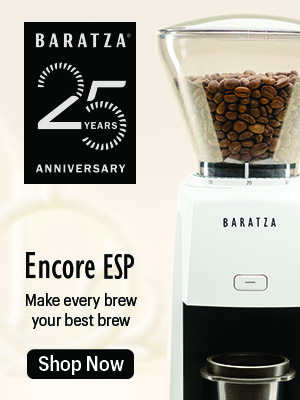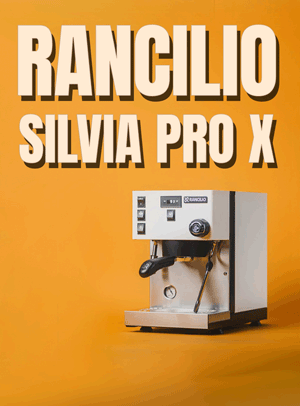
A big, huge, gargantuan trend in barista circles is the latte art throwdown. You’ve probably heard of this thing – a bunch of baristas gather, be it at a party held during the SCAA, at regional barista competitions, at barista jams, etc, etc, and they kick $5 into the pot for a winner take all competition for who can pour the best latte art.
These contests are great, if nothing else for the camaraderie they cause. These competitions make baristas feel part of a community and they are always a ton of fun.
As far as advancing the actual art and skill of making great coffee, they don’t contribute too much, except perhaps how to steam milk better and with better texture. Perhaps there is one more benefit to quality: latte art throwdowns also have a long term effect of improving coffee by facilitating the network and community within the barista corps.
But one thing latte art throwdowns are not is a quality-in-the-cup improvement competition. There’s nothing in these contests to challenge the barista to make a better cup of espresso. Nothing much in the competitions to foster an environment that seeks to understand the process of turning a whole roasted bean of coffee into a magical elixir of heavenly goodness in the cup.
There is a competition out there in various formats that does achieve this and has many of the community building aspects of the latte art throwdown, but it’s not one that is nearly as common. It is called the Spro Down, at least at the ones I’ve attended. So what is a Spro Down?
Head to Head Espresso Challenges
The first Spro Down I ever saw was actually one I competed in. It was in 2003 at a party I hosted after the inaugural Canadian Barista Championships. Dismas Smith, the 2002 North American Barista Champion and I got into a bit of a jawing match regarding pulling shots on commercial machines vs consumer machines. I had a commercial La Marzocco Linea at my place alongside a variety of consumer espresso machines, so Dismas and I concocted a skills test. We’d use a neutral (and kinda crappy) coffee from an Italian roaster (the coffee was at least 2 months old), and we’d each pull shots on two setups: one set on the La Marzocco with a Mazzer Super Joly grinder, and the other set on a Rancilio Silvia with a Baratza grinder. We’d get two dial in shots, and then have to pull a double to serve to the judges. Our judges were WBC certified judges who were also at the party.
Dis would pull his set on the Linea/Mazzer setup, me on the Silvia / Baratza rig, and serve the judges. Then we’d switch, and serve the judges again. They would taste blind – they wouldn’t know who’s coffee was who’s; nor would they know which machines pulled which shots.
Dismas beat me. Both times. It was humbling, but also showed that he knew a helluva lot about the process of making espresso and how to tweak his setup and settings to get the most out of a rather crappy coffee.
That was pretty informal, but it was a pure challenge of two baristas trying to pull the best shot possible with very little foreknowledge of the elements involved. Over the next few years, I was witness to several head to head “spro downs” between a few baristas (including the infamous battle between Paul Bassett and John Hornall at Hines Public Market Coffee in 2005) but as latte art throwdowns started to get popular in 2006 and 2007, nothing to match their scale happened in tests of true espresso making strength… until mid 2007.
The First Spro Down
One of my favourite people in coffee, a fellow known as the espresso poet, Jon Lewis, contacted me in early 2007 about a new cafe his friends were opening up and about a party they wanted to hold at said cafe for the barista community. This event was called the Sunrise Barista Jam and it happened at Vancouver’s Radio Station Cafe. Lewis came to attend, as did a surprise guest – Billy Wilson, who made a last minute decision to drive up from Portland to attend. All told, there were at least 30 people in and out of that party and gathering over the evening.
Lewis also asked me if I’d be a judge in a competition they’d devised for the Jam – an alternative to the booming latte art throwdowns, he said. Something that would showcase the barista’s skill in more real ways in terms of what was in the cup. They called it a Spro Down.
Now, there may have been other Spro Downs of this type in the past, but I am not aware of them (know of any prior to 2007? if so, tell me in the forum comments!).
The competition was simple in concept but darned hard in execution. Any barista who was interested in trying out would put their name and a few bucks into the pot. They’d step up to a machine unfamiliar to them, a grinder equally unfamiliar, and use one of two guest coffee blends that were in the hopper. They’d get to pull three shot pulls – three doubles. They could use the first two as dial in shots, adjusting the grinder / dose / flush as needed, and serve the third double pull. Or they could serve the second, or even the first if they chose.
Two judges, both with formal espresso judging experience were selected to taste the shots. Judges would have to come up with their own scoring system (we set up six things to score 1-5 on) and pick a winner. And the winner would take all.
It was a great competition and very well received. I shot a lot of video that night, and cut together a short film to showcase the event.
here are some problems with this kind of competition – and the main one is palate fatigue for the judges. When you have 10, 12, 16 baristas competing or more, that is a LOT of espresso for a judge to drink. I am sure there’s better ways for the judging to work and I have one suggestion below on this.
Another problem is this kind of competition does favour baristas familiar with the machine and grinder in question – namely baristas who work at the host shop. But again, I do have some suggestions on how to deal with that.
One thing this competition did that no latte art throwdown could ever do: It drove home the point that an intrinsic knowledge of the espresso making process is utterly important to the quality produced in cup. Baristas who were amazing on their comfortable setups at their own cafes stumbled when working on foreign equipment and foreign espresso blends. Other baristas showed such arcane knowledge of the process that they were able to do minute adjustments to their preparation methods, including cooling down the portafitler a bit before inserting into the machine, or doing an extra long grouphead flush – all things that provided incremental improvements to the taste of their coffee.
The other baristas at the event would see these things, and curiosity would lead to questions. Information was exchanged, and many of the people at the event left with a better knowledge of the process involved in getting a great shot of espresso. This has a steamroll effect. As these baristas went back to their shops and their own communities, they brought with them the knowledge and newfound excitement in experimenting with espresso, and they’d share this with their own team and friends.
This is where I get a bit sad about latte art throwdown competitions and perhaps the main reason why I am not a fan of these milk pouring events these days. If I had to guess, there is probably one Spro Down happening for every twenty latte art throwdowns going on. For whatever reason, barista communities around the US and Canada don’t find the Spro Down as “sexy” or intriguing as the latte art throwdown. Perhaps the Spro Down is too technical. Perhaps it is too difficult. I don’t want to think it is just all about the fluff, and not about the substance – but perhaps there is some truth in that too.
Community building is very important to me – be it here on CoffeeGeek or within the coffee community as a whole. Latte art throwdowns build community and that is one of its greatest strengths. But Spro Downs also build community while advancing exploration and understanding in how to make espresso better. There should be more of them, and perhaps soon there will be.
Hosting a Spro Down
If you are interested in hosting a Spro Down competition, here’s some suggested rules and ideas on making it happen.
Coffee Choice
Have at least two “guest coffees” on tap, each in its own grinder. The grinders should be as equal as possible. Consider having a single origin in one, and a blend in the other. Don’t put your own shop’s coffees in the grinder, but instead, source coffees from a reputable roaster that is unfamiliar in your own community / area. Let the competing baristas choose which they want to use for their shot pulls during their round in the competition.
Warm Up / Reference shots
Ask the most skilled barista in your shop to dial in and pull shots from both coffees. Let them find the best dial-in for the coffees. Ask the roaster for their dial-in parameters as a starting point. Once your barista is happy with the shots, have him or her pull shots as reference points for all the competing baristas to taste. This way, the competitors know going in what tastes they are potentially dealing with. Also let the judges taste the reference shots so they have an idea as well.
Sign Up
Baristas sign in by putting down cash ($2? $5? $10? Whatever) that goes into the pool. If expenses took place that aren’t covered by anyone (ie, purchasing coffee from a roaster) this is a good way to recover some of the costs – use some of the pool money (and make the sign in rate appropriate) to pay for costs and keep the remainder for the winner. If expenses are covered (or coffees are donated), then 100% of the pool goes to the winner.
Judges
I’d recommend having three judges for up to 15 entrants (though 12 competitors is a sweet spot). If you have more competitors, logistics and time is a pain so you may want to keep entries to 15 maximum. The judges would rotate for each competitor – judges A and B judge the first competitor, judges B and C the second, judges C and A for the third, and so on. This helps minimize palate fatigue and still keeps things relatively fair for all the competitors as all are judged by one pool of judges.
Shot Pull Criteria
Competitors have to pull something akin to a traditional double – that means a total shot volume of at least 40ml (1.5oz) but 60ml (2oz) is preferred. These shots must be done in a spouted portafilter pouring into two cups. The baristas can choose what cups, how hot or cold the cups are, etc.
The Shot Pull Process / Dial In
The baristas are allowed three shot pulls. They choose which coffee they want to use (SO or blend), pull their first shots, taste, evaluate, and make adjustments necessary. They can even switch if they want between the SO and blend. A second shot pull can either be served to the judges or evaluated by the barista for any further adjustments. The third shot pull is their last one and must be served to the judges if they haven’t already been given an espresso to taste.
Time Limits
Enforce a strict 5 minute time limit for each barista. Time starts the moment the barista steps up to the machine and says “start”. They cannot do any adjustments or prep before their starting time. This time limit could be anything (3 minutes? 7 minutes?) but should be enforced. If a barista exceeds the time limit and has not served a shot to the judges, they are disqualified. Serving the judges themselves is part of the 5 minute time limit.
Cleaning machine
All baristas must clean the machine, grinder and work area after their 5 minute competition. Perhaps allow 3 minutes for this (timed), which also gives the judges time to evaluate their drinks and score the results.
Judging criteria
The judges must be selected by the community at the event and should be people with recognized tasting experience. Suggest the host’s staff, or the host themselves as judges. Also suggest judges familiar with the guest coffees.
Judging score sheet
The judges should devise their own scoresheet and how to score, but here are some suggestions. Score on a scale of 1-5 each of the following: crema colour, crema persistence, aroma, temperature, body, balance, aftertaste, presentation, and overall.
Winner
The winning score takes all. In the case of a tie, you could have a head to head spro down between the top two, or split the winnings.
Who should not compete
These events are usually hosted at a cafe, and the staff and host have an distinct advantage in being familiar with their espresso machine and their grinder. As hosts, they would serve the competition better by being facilitators and what is known in the barista competition arena as “runners” – the folks cleaning cups, keeping the workareas clear and ready for the next competitor.
Conclusion
Spro Downs are more challenging than latte art throwdowns, both in execution and in evaluation. But they also give much more back to the community. They build skills in real way: skills that benefit baristas, shop owners, the community as a whole and customers in your cafes. They develop new understanding of, and experience in the process of making a great espresso. They aren’t as flashy as latte art throwdowns, and don’t present as many nice visuals, but they do make us better baristas.
They are very doable though. The Sunrise Barista Jam proved that, as have various Spro Downs since. They are engaging and exciting in their own ways. There are also many ways for the baristas to stand out – besides developing a great taste in the cup, by virtue of the fact that “presentation” is one of the scoring criteria, baristas can showcase their ability to interact with the customer and come up with unique ways to stand out from the other competitors. Take that, “absurd latte art challenge”!
Hopefully we’ll start seeing more and more of these as we continue to improve our skills in making coffee’s most difficult drink.































